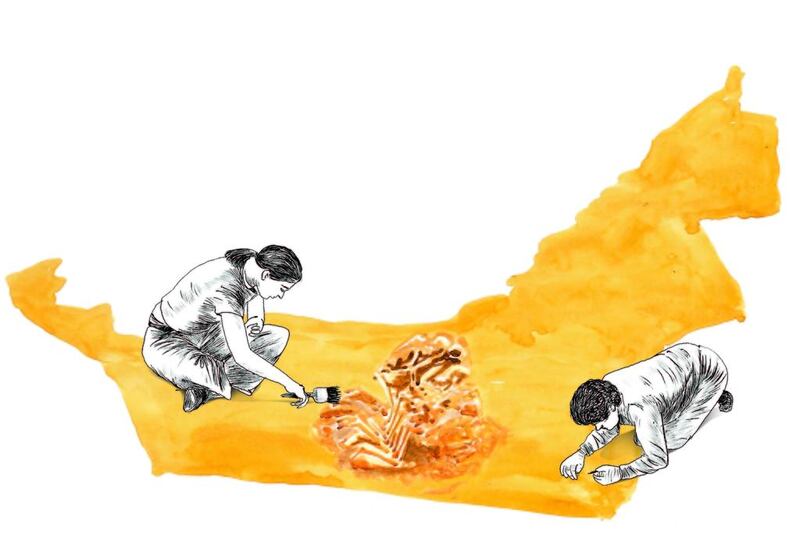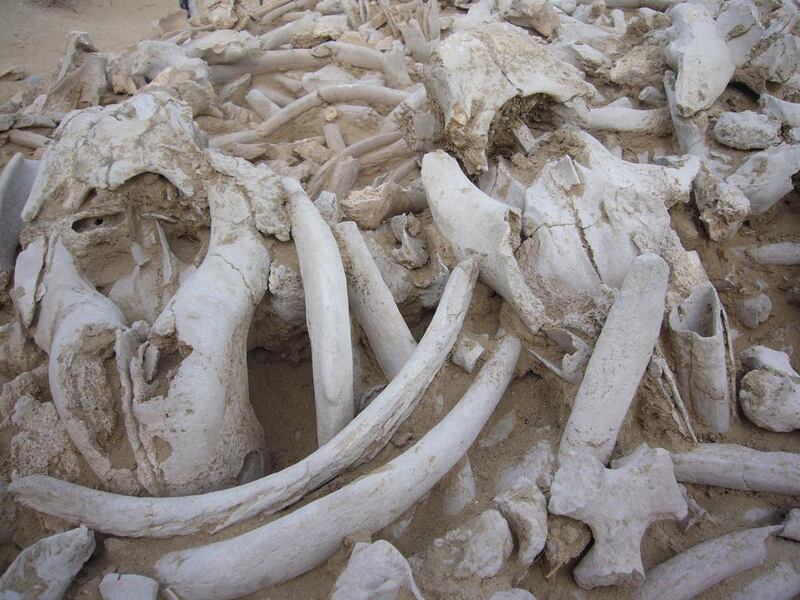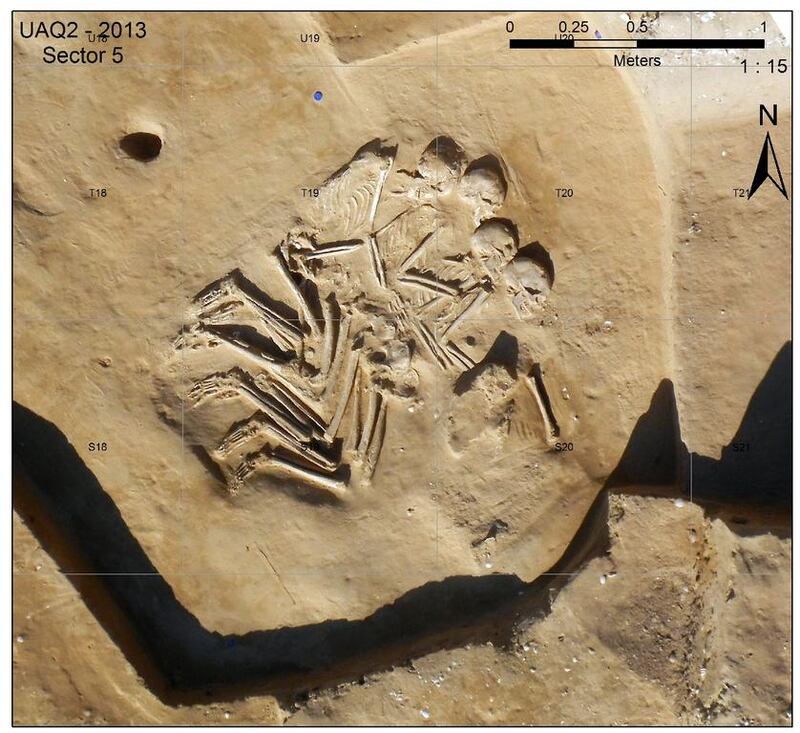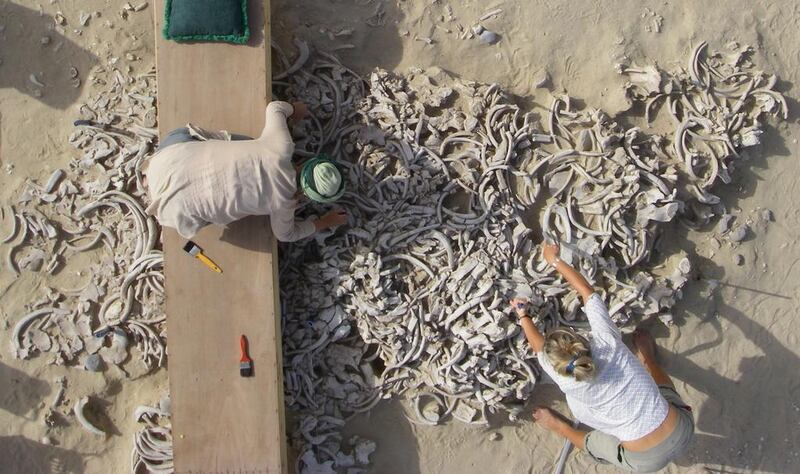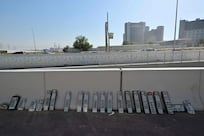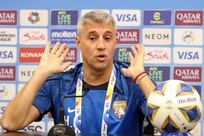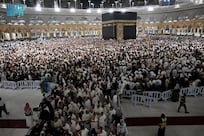The bodies in the grave unearthed by Sophie Mery’s archaeological team in Umm Al Quwain may be the product of extreme violence, but thanks to the grave’s age and the way that its contents were ritualised, that burial place of four men has become an object of rare beauty and enlightenment.
The grave was discovered in 2013 at an existing archaeological site called Umm Al Quwain 2 (UAQ2), which sits on the edge of a lagoon close to the busy E11 road that now links Dubai with the northern emirates.
The earliest finds uncovered at UAQ2 date to the 6th millennium BC, which make the site the oldest Neolithic coastal settlement to have been discovered on the southern shores of the Arabian Gulf. It was among the oldest layers that Ms Mery’s team made their remarkable discovery.
In a pose reminiscent of an Eadweard Muybridge’s photographic motion study, the bodies in the grave lie united in a chain of death.
Four of the bodies lie carefully arranged on their sides, tucked together as if in sleep, with the right arm of each resting on the body in front of it. A fifth body also lies in the pit, nearby but apart from the others, resting a more foetal position.
Ms Mery believes the young men, who are believed to have been in their early 20s, died as a result of conflict and were buried together in what must have been a purpose-built pit tomb.
“It’s what we call a multiple grave. From the time of the death and interment of the first and fourth persons in the tomb, there was no more than a week,” explains Ms Mery, an archaeologist who is also the director of the French archaeological mission to the UAE.
“The size of the pit indicates that it was made for the bodies at one time, and the very careful arrangement of those bodies in a chain of death must have been very symbolic,” Ms Mery says.
“In the chest of the first man we found a flint arrowhead, which at the point of impact had destroyed his ribs, while two of the other men, who were interred later, had pearls placed at the level of their hips.
“The fact that we found these pearls grouped together, two pearls with one of the men and three pearls with the other, means that they were probably wrapped in a piece of textile or in a small bag.”
For Ms Mery, the fate of the men in the grave sheds important light on the life of the communities who inhabited the coast up to 7,500 years ago.
“This Neolithic tomb is totally different from the early Bronze Age, or Umm an Nar tombs in the region which were collective graves,” the archaeologist explains.
“Those were monuments that could be opened and reopened and in some cases had as many as 700 bodies deposited in them over a period of 200 years.”
Thanks to the discovery of later finds and subtle details that distinguish these from material discovered at nearby sites, Ms Mery believes that the UAQ2 grave is evidence of inter-group violence.
“At one point at least four young men were killed but the group was sufficiently large to survive and the site continued to be occupied by the same community,” she says.
“We know this because they used the same objects and the style of their jewellery is distinctive from that found at other Neolithic sites at Akab and Buhais.
“Buhais is a well-known cemetery from the 5th millennium BC and if you study the jewellery there its style is sufficiently different to tell us that the people at UAQ2 or Akab did not belong to the same group.”
The burial at UAQ2 is just one of the case studies that Méry will discuss in her lecture, The Neolithic & Bronze Age as Cultural Roots of UAE Identity, this evening at New York University Abu Dhabi.
The examples span her four-decade career, which began in Al Ain in 1980 when Ms Mery was still a student. Also being discussed is her more recent discovery of a Neolithic ritual site on the island of Akab which, like UAQ2, also lies on a lagoon along the coastline of Umm Al Quwain.
Constructed from dugong ribs, skulls and mandibles, the structure, which closely resembles more recent dugong temples that have been found in Australia, it is believed to be one of the oldest ritual sites discovered so far in Arabia.
“I feel very lucky to have been able to work on such extraordinary sites because of the data we have collected,” Ms Méry admits. “Not just because of the facts that we find but because sites like the dugong mound allow us to ask questions at a level that we rarely reach in archaeology.”
Not only will tonight’s lecture paint a picture of the millennia that witnessed Eastern Arabia’s transition from the Neolithic to the Bronze Age but it will also discuss the proper role that ancient history and archaeology should play in the present.
“It is not just in the interest of archaeologists but of the country that the past is well understood and I think it is our duty to communicate our knowledge to the people of Abu Dhabi, whether they are nationals or non-nationals, to contribute to the construction of a national identity,” she says.
But as the University of Chicago-based anthropologist Michael Dietler has written, such a perspective, which locates archaeology at the intersection of academia and contemporary identity politics, is one that is fraught with challenges.
“By the nature of their endeavour, archaeologists find themselves in an ambiguous and delicate position as both the furnishers of the symbolic hardware of traditions and the potential agents of deconstruction for those traditions,” Mr Dietler wrote in his 1994 study Our Ancestors the Gauls: Archaeology, Ethnic Nationalism, and the Manipulation of Celtic Identity in Modern Europe.
“Archaeology provides for the popular imagination tangible connections to an identity rooted in the awe-inspiring past. Places and objects can be made into powerfully evocative symbols that serve to authenticate constructed traditions.”
For the University College London-based archaeologist Tim Schadla-Hall, concern about the relationships between archaeology, nation building and identity may seem like a very current concern but the issues that the relationships raise are as old as the discipline itself.
“In many ways archaeology has always operated as the handmaiden of nationalism,” says the academic and editor of Public Archaeology Journal, who has a particular interest in how the past is produced in the present and the present invents and manipulates the past.
“The use of the past for political purposes is one that you can see throughout the history of the subject and its connection with identity has always gone on, but it’s absolutely critical that archaeologists put the work they do in a broader, justified context which explains what the past should mean to most people and why its significant,” says Mr Schadla-Hall.
“The point is to clarify and show people, without making things academically complicated, that the past is a foreign country where we can understand all sorts of things about the past without relating ourselves directly to it.”
For Ms Mery however, there is no contradiction between academically rigorous archaeology and the sense of pride, rootedness and unity that can stem from a sense of shared history and a knowledge of the distant past.
“I’d like the public to understand how important it is to understand the past, not just of your own country but of the country you have chosen to live in whatever your nationality,” she tells me.
“As a federal state, the UAE is relatively new compared to 7,500 years of history but a cultural identity developed and was elaborated by people’s need to optimise [the available] natural resources, by their knowledge of their environment and by the need of those communities to adapt and deal with climatic change.”
To borrow the words of one of Ms Mery compatriots, the French critic, journalist, and novelist Jean-Baptiste Alphonse Karr, when it comes to the fundamental factors that define life in the UAE, the archaeological evidence suggest that the situation is very much a case of plus ça change, plus c’est la même chose [“the more it changes, the more it’s the same thing”].
nleech@thenational.ae
• A public lecture, The Neolithic and Bronze Age as Cultural Roots of UAE Identity takes place this evening at the New York University Abu Dhabi campus.
